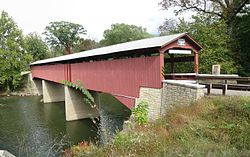
As of 2007, there are a total of 21 covered bridges in Columbia County, Pennsylvania, in the United States. The number of covered bridges in Columbia County is the third highest number of covered bridges in any one county in Pennsylvania, behind Washington County and Lancaster County. [1] [2] Columbia County is also home to one of two sets of twin covered bridges in the United States. [1]
Contents
By 1962, a large number of the covered bridges in Columbia County were experiencing weathering. During this year, Columbia County began working on the preservation of the damaged bridges. [3]
There is an organization known as the Columbia County Covered Bridges Association that has existed since 1991 and supports the presence of covered bridges in the county. The county commissioner of Columbia County, Chris Young, is also a supporter of Columbia County's covered bridges, stating that "When you stand on a covered bridge, you're actually going back in time". [2] 18 of the covered bridges are open to vehicle traffic, as of 2002, and these are maintained by officials of Columbia County. The remainder of the bridges are maintained by the Columbia County Covered Bridges Association. A number of the covered bridges are attractions for local and regional tourism. They are also used for picnics and fishing. [2]
A number of the covered bridges were damaged during Tropical Storm Lee in 2011. Three of these bridges were the Josiah Hess Covered Bridge No. 122, the Davis Covered Bridge, and the Rupert Covered Bridge No. 56. The Josiah Hess Covered Bridge No. 122 received some damage to its abutments. The Davis Covered Bridge was closed after the tropical storm. The Rupert Covered Bridge No. 56 sustained minor damage from a tree branch that went through its side. [4]



















